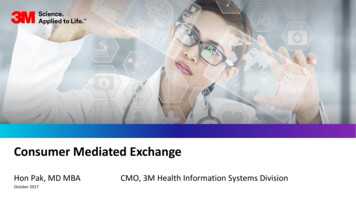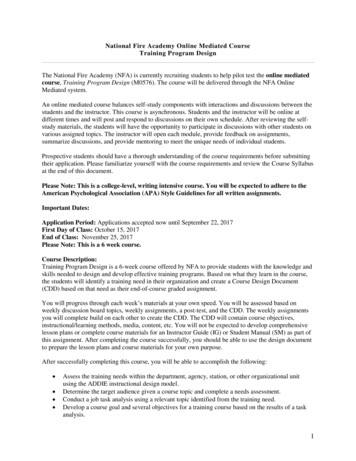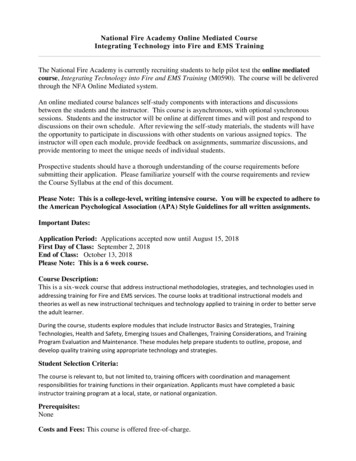
Transcription
Consumer Mediated ExchangeHon Pak, MD MBAOctober 2017CMO, 3M Health Information Systems Division
A Value-Based Care World is Uncharted and Filled with Risk andUncertaintyhttps://www.youtube.com/watch?v skchMGisZTg Barriers: 18 December 3M 20172. All Rights Reserved. 3M Confidential.Longitudinal data (Claims and Clinical and Other)Payment ModelsStructural Issues in HealthcarePatient EngagementInteroperabilityData outside healthcare2
Healthcare Data10%Most data about the patient isoutside the healthcare system andmuch of it is in an unstructured form90%Data Outside HealthcareSystem3
Value-Based Care: It’s More than Clinical DataDeterminants of Health Outcomes – Clinical CareClinical Care is estimatedto represent only 20% ofoverall outcomes(measured by length andquality of life).Market needs a greateramount of actionable data,validated measurementand toolsUniversity of Wisconsin Population Health Institute developed estimates ofthe determinants of health outcomes for the County Health Rankingsproject (2010).
Accenture Consumer Survey on Patient Engagement 57% of consumers track their own health data 84% of consumers think they should have complete access to all of theirEHR data 40% of consumers would consider switching providers to obtain onlineaccess to their EHR data 71% of consumers feel they should be able to update their electronichealth recordsSource: tailWebinar Reg.aspx?ItemNumber 27250
Agenda What is the state of consumer mediated healthcare exchange Regulatory changes that impact patient access to data Barriers to consumer mediated exchange How mobile technology can enable consumer ownership of their data
Background: Interoperability The Health information exchange (HIE) market is projected to reach USD1,545.0 Million by 2020 from USD 990.6 Million in 2015, at a CAGR of 9.3%. Existing HIE market largely grew thru funding from HITECH to address EHRinteroperability, and it is largely provider focused and exist at local/regionalor state level. Most are connected to a national HIE network (query based) andincreasingly, large EHRs allow exchange thru this type of HIE or via a directsecure message (email). Most believe that HIEs are not fully mature or being widely used due totheir limitations and lack of a sustainable business model.
HITECH In March 2010, as part of the Health Information Technology for Economicand Clinical Health (HITECH) Act, the ONC awarded funds as part of theState Health Information Exchange Cooperative Agreement Program. State designated HIE entities received nearly 548 million through thisprogram, which funds states' efforts to rapidly build capacity for exchanginghealth information across the healthcare system both within and acrossstates, according the ONC.
HIE: Solution to InteroperabilityHealth Information Exchange was intended to address key issues surrounding Quality of Care Improvement Cost Containment of Health Care Health Care Information AccessibilityPromise Promoting the secure exchange, use and sharing of patient information Reducing the frequency of medical redundancy & errors Providing complete record of the patient’s health encounters and interactions Improving patient outcomes individually at the clinical level and in aggregate at the public health management level Improving care coordination Empowering patients to become more involved in monitoring and managing their own health careYET . Interoperability is still largely focused on providers and unsolved
Forms of Health Information ExchangeQuery-Based Exchange Query-based exchange is used by healthcare professionals to search for clinical sources on a patient. This type ofexchange is often used during emergency care. Limited based on knowing where patient has the dataDirected Exchange Directed exchange allows healthcare providers to quickly and securely send patient information to otherhealthcare professional. Patient referrals, lab orders and results and prescriptions are easily and securely sent via the internet in encryptedfiles; it’s as simple as sending and email.Consumer-Mediated Exchange Consumer-mediated exchange allows patients to manage their healthcare information online just as they wouldmanage their finances online with banking. A consumer-mediated exchange allows patients to be in control of their vital information and can assist incoordinating care. Patients can provide other healthcare professional with their medical histories, assist in updating personalinformation and billing issues.
Ongoing Challenges of Healthcare Interoperability Technical View – Sharing of data is complicated: Medical records are voluminous and complex Patient privacy - regulations vary by state Security of patient information -- access controls in a mobile and disparate environment Interoperability standards are still evolving Patient Identification without a national standard Business View – in search of a sustainable model: Paradigm shift – Competitors must be willing to share certain patient medical information withone another Focus moves from who controls the patient data to how a larger pool of available patient datacan be used to better treat the patient Business Model/ Sustainability is the ultimate challenge
Healthcare v. Banks Do you know about an app that allows you to securelyintegrate multiple banking accounts into one view? Many patients, particularly those with complex chronic or lifethreatening conditions (e.g., transplant, advanced cancer),often have multiple portals from multiple providerorganizations and specialists.How Close Are We to Consumer-Mediated Exchange? Posted on May 20, 2015 by John Sharp, MSSA, PMP, FHIMSS by SriBharadwaj, president-elect, Southern California chapter of HIMSS; member, HIMSS Value of Provider-PatientEngagement Task Force; and director, information services, UC Irvine Health
HIPAA and Information Blocking Under provisions of the Health Insurance Portability and Accountability Act of 1996(HIPAA), providers must share patients’ records within 30 days on request. But health providers’ data about their patients is a valuable economic asset that somedoctors and hospitals are understandably reluctant to share with their competitorsdown the street. Many patients stick with clinicians and hospitals in part because that’s where theirrecords are. If the records can travel, so may patients, taking their business with them. Also, many providers believe that they – not patients — own that information, andhave no obligation to share it. A recent federal report cites this “information blocking” by providers as an importantobstacle to HIE. Legislative and regulatory remedies to information blocking are underreview, but there may be another, equally powerful route to HIE: giving patients theirrecords so they can decide who can have them and when.
Mindset or Culture: Data is Power One impediment is a health system mindset or business model that seespatient data as a proprietary asset. Rather than creating affinity by offering an excellent experience, they wantto do it by making it hard to move. Data are being sold in ways that bypass patient. We need to create a culture where this is done in a way that minimizesdependence on data holders/custodians The consumer should be in control. There needs to be stringent privacy andsecurity, and no data moves without patient permission.
2017 ACI Transition Measure: View, Download, or Transmit (VDT)Under the Merit-based Incentive Payment System (MIPS) pathway of the MACRA Quality Payment Program,the Advancing Care Information (ACI) category replaces the Medicare EHR Incentive Program (MeaningfulUse).Patient Electronic Access: View, Download, or Transmit (VDT). At least one patient seen by the MIPS eligibleclinician during the performance period (or patient-authorized representative) views, downloads ortransmits their health information to a third party during the performance period.Reporting Requirements Numerator: The number of unique patients in the denominator (or their authorized representatives) whohave viewed online, downloaded, or transmitted to a third party the patient’s health information duringthe performance period. Denominator: Number of unique patients seen by the MIPS eligible clinician during the performanceperiod.
Data Ownership: Legal Perspective Patient Records: The Struggle for Ownership. “There is no consensus on who owns medical records. The Health Insurance Portability and Accountability Act (HIPAA) does not specify ownership, and state lawsare inconsistent. Only New Hampshire has a law stating that patients own their medical records. In 20 other states, providersown them. The rest of the states have no legislation addressing the matter, according to an analysis of statelaws by Health Information & The Law, a project of the George Washington University’s Hirsh Health Law andPolicy Program and the Robert Wood Johnson Foundation. Legal opinions on the matter differ as well. Daniel Shay, JD, an attorney with Alice Gosfield & Associates inPhiladelphia, says, ‘The general understanding of the legal community is that patients own their records, orit’s their interests that are ultimately paramount.’ Michael Bossenbroek, JD, a partner in Wachler & Associates, of Royal Oak, Michigan, says Michigan doesn’thave a clear rule regarding record ownership. ‘The default setting is that the records belong to the providerwho has the control over it,’ he says.” (Medical Economics, 12.10.15)
Is This Consumer Mediated Exchange Real?
Consumer-mediated health information exchanges: the 2012 ACMI debate.J Biomed Inform. 2014 Apr;48:5-15. doi: 10.1016/j.jbi.2014.02.009. Epub 2014 Feb 20. The American College of Medical Informatics (ACMI) sponsored a session on"Resolved: HealthInformation Exchange Organizations Should Shift Their Principal Focus to Consumer-Mediated Exchangein Order to Facilitate the Rapid Development of Effective, Scalable, and Sustainable Health InformationInfrastructure." Those supporting the proposition emphasized the need for consumer-controlled community repositoriesof electronic health records (health record banks) to address privacy, stakeholder cooperation, scalability,and sustainability. Those opposing the proposition emphasized that the current healthcare environment is so complex thatdevelopment of consumer control will take time and that even then, consumers may not be able tomediate their information effectively.
CARIN [Creating Access to Real-time Information Now throughConsumer-Mediated Exchange] Alliance Purpose: On July 7, 2016, David Blumenthal, David Brailer, AneeshChopra, & Leavitt Partners co-convened a multi-sector groupAttendees: Over 45 participants representing the following sectorsattended the meeting: Consumers, Providers, Payers, Government, etcAs a follow-up to the inaugural meeting on May 26, 2016, this meetingfocused on what the alliance is trying to achieve, the barriers that exist inconsumer mediated health information exchange, and what the groupcan do to remove those 6.pdf
CARIN Actions (not full list)Assessing the impact of CMS’ APM regulations As CMS continues to propose regulations related to MACRA, APMs, and MIPS,develop a strategy for responding to those regulations during the NPRM process toensure the liberation of patient data will not be curbed.Hackensack technology partnership Develop an ecosystem of providers in the tri-state area who will begin to share dataacross organizations. Develop a case study regarding how Hackensack implementedtheir solution. Work with other interested organizations on how Hackensack was able to buildaccessible consumer health information using the FHIR APIs.
Precision Medicine Initiativehttps://allofus.nih.gov/ The director of the Center for Outcomes Research and Evaluation atYale-New Haven Hospital in Connecticut, Krumholz argues thatputting the patients in control of their data and making it easier forthem to participate in research has the potential to disrupttraditional models of research PMI is creating the ability for consumer-mediated exchange, he said.“It could be a means by which we can leverage a partnership withpeople and potentially decrease the cost of data acquisition andimprove the accuracy and scope of data being collected.”
NATE and CommonWell The National Association for Trusted Exchange (NATE) and CommonWell HealthAlliance announced that each would become a member of the other’sorganization. They have agreed to establish a mutual synergistic and complementaryrelationship with the goal of enhancing cross-vendor interoperability to betterassure provider and patient access to health data regardless of where careoccurs. NATE is a not-for-profit membership association focused on enabling trustedexchange among organizations and individuals with differing regulatoryenvironments and exchange preferences.
Consumer Mediated Exchange: HRBA The left-leaning Progressive Policy Institute and the right-leaningHeritage Foundation. These two organizations supported a bill inCongress that had bipartisan support entitled “the IndependentHealth Record Trust Act of 2007.” Today, the original policy analysts for these organizations remainsteadfast in their support of this concept as members of the HealthRecord Banking Alliance Advisory Board (HRBA), together with HIMSSVice President Tom Leary and other leaders and chaired by TedShortliffe, MD, PhD, the former president and CEO of the AmericanMedical Informatics Association (AMIA). ge.html
What is an independent health record trust/bank? A health record bank (HRB) or trust is an independent organization that provides asecure electronic repository for storing and maintaining an individual’s lifetime healthand medical records, obtained from multiple sources, and assuring that the individualcontrols who accesses the records. Should Congress reconsider establishing such a regulated, bank-like infrastructure(with opportunities for multiple technical infrastructure vendors) that also facilitatesvalue creation as shown by the SMART Platform work funded by HHS(www.smartplatforms.org)? With more opportunities for consumers (patients) to view or obtain their healthinformation from separate “silos,” including genomic mapping and associated diseaserisk data, and the need to organize and share Patient Generated Health Data withphysician/hospital EHRs, the timing has never been better to consider even betteroptions for C-ME facilitation.
Lessons Learned from Past Efforts Earlier efforts to create personal health records by companies suchas Google, Microsoft and Dossia. Ultimately failures because they were more like scrapbooks with noway to move the data. They didn’t focus enough on the use case of what patients would dowith the data once they had it. Healthcare is local and ProviderPatient relationship is essential.
Challenge: Unique Patient Identifier? The 1996 Health Insurance Portability and Accountability Act (HIPAA) called for athe creation of “a standard unique health identifier for each individual.” [nationalpatient identifier (NPID)] NPID: Essentially a social security number (SSN) for medical records, a unique NPIDwould be assigned to every person in the U.S. and tied to their entire medicalhistory, from birth to death. Unique medical IDs are not a new idea. Over 30 countries, including Singapore,Australia, and Britain, In 1998, Congress removed the provision of the unique patient identifier fromHIPPA and even prohibited using federal funds to establish an NPID.
Mobile enabled Consumer Mediated Exchange Mobile Devices/Wearables given its pervasiveness and proximity represents our bestchance to collect data and engage our patients Mobility solution represent a key component to providing a portable and easy to useaccess and management of their data The challenge is the network effect or lack there of Technology Enablers like Block Chain combined with disruptors such as Apple providesome hope that some of the policy and cultural challenges could be addressed.
ONC announced the Phase 2 winners of its Move Health DataForward Challenge [Technology is there]The ONC launched the competition to get companies working on “consumer-mediatedexchange” of health information. Already, the ONC's Nationwide Interoperability Roadmap's2015 to 2017 goals include enabling consumers to send, receive and otherwise use theirhealth data. Some of the winners of the contest's second phase: CedarBridge Group makes CareApprove, an app that lets patients give and take away their providers' accessand ability to send and receive their health data. A plug-in allows providers to connect the app to electronichealth records. HealthToGo, created by software company EMR Direct, can be used to store healthcare data from multipleproviders, thereby creating a longitudinal patient record. Like CareApprove, the app allows patients to grantor revoke access to the data. Foxhall Wythe's Docket relies on end-to-end encryption for security and fast healthcare interoperabilityresources, or FHIR, a set of standards for interoperability, so patients can share information from multiplehealthcare providers. Lush Group's HealthyMePHR pulls data from patients' primary care EHRs. Through the FHIR-based platform,patients can choose how their information is shared by granting specific access.
iShare Medical iShare Medical Messaging provides you with an iShareID Direct addressthat uniquely identifies you and can be used to get medical records from allyour providers into one central location. In addition, iShare Medical Messaging can be used to safely and securelysend and receive messages to and from your doctor or other medicalproviders. Your iShareID Direct address looks and works like an email address, but thisis no email system. iShare Medical Messaging can only be used with yourmedical providers who have a secret key that will allow safe and secureexchange messages over an encrypted network.
Health Companion is a tool to engage, empower, and inspire people to achievebetter health at lower cost. Health Companion has four major features. A secure life-long personal health record (PHR). A personal, confidential health network to communicate with yourproviders, health coaches, specific communities, friends, and family. You arealways in charge of your information and you decide how, when, and withwhom it is shared. A tool for managing your medical bills, insurance claims, and healthaccounts such as FSA and HSA. A tool for personalized preventive health & wellness recommendations andfollow-ups Health Companion is a certified Patient Portal under Meaningful Use,and an accredited provider of Direct messaging services as a HISP, CA, and RA.
Secure Exchange Solutions Secure Exchange Solutions is the leader in Direct Secure Messaging forconsumers. Over 10 million patients have access to Direct Secure Messaging throughour network of patient portal and patient application partners. Secure Exchange was the first independent HISP to have a consumeranchor accepted as part of DirectTrust, empowering consumer healthapplications to exchange data with physician applications without the needfor custom interfaces. They offer the most flexible deployment options for easy integration andrapid time to market
Humetrix: Mobile Health Platform for consumer Engagement, Value BasedCare and Personalized Medicine http://www.ibluebutton.com/consumers.html selects-humetrix-mobile-ehr-app/ California HIE touse Humetrix iBlueButton app With Cerner, Humetrix Demonstrates DIRECT and Mobile Enabled Provider-to-Patient EHR Exchange forInteroperability at Health 2.0 Fall Conference - Santa Clara, October 1, 2017 Humetrix Focuses on Patient-Mediated Data Exchange Applications for Interoperability at ONC DirectExchange Workshop - Washington, DC - June 2, 2017 At HIMSS Humetrix Focuses on Patient-Mediated Data Exchange Applications for Interoperability - DelMar, CA - February 9, 2017 At CES, Humetrix Shows Technology to Help Consumers Drive Needed Healthcare Reform - Las Vegas,January 5, 2017
Health Wallet HealthWallet deploys a suite of best-in-class digital healthcare technology features tobring convenience and transparency to the already complex and confusing healthcaresystem. They put members in control of their health costs. Through on-demand access toproviders and the ability to understand the cost for prescriptions and medicalprocedures before they get them.http://www.thehealthwallet.com/home
Argonaut Project on health records, interoperability could get thepush it needs with Apple Healthkit Apple is said to be working with the Argonaut Project to integrate more electronichealth data with the iPhone, a move experts say could go a long way towards advancingmedical record interoperability. Participants in the Argonaut Project – an HL7-led initiative focused on expanding theuse of open standards for health data exchange, notably HL7's FHIR specification Some of the industry’s most notable vendors and providers: Accenture, athenahealth,Cerner, Epic, McKesson, Meditech, Surescripts, The Advisory Board Company, BethIsrael Deaconess Medical Center, Boston Children's Hospital, Intermountain Healthcare,Mayo Clinic, Partners healthrecords-interoperability-could-get
To move forward with consumer-mediated HIE, several steps will be required. First, the federal government needs to more aggressively enforce HIPAA’sinformation-sharing provisions. Second, we need a new cohort of health-data stewards who can helppatients manage their own data. Some process of private certification orpublic regulation will likely be necessary to assure that these new entitiescan be trusted to discharge this sensitive and complex responsibility. Third, we will need to perfect the technical ability of these new datastewards to access the electronic-data repositories of health-care providers.
WHY DOES THIS MATTER ? Most current models treatBob and Dave the same(same sex, age, illness burden but different outcomes)18 December 3M 2017BobDave 43yo 43yo Diabetes Diabetes Hypertension Hypertension COPD COPD Lives at home with his wife Lives alone Employed with good healthinsurance Occasionally employed, no healthinsurance Engineer who uses apps andspreadsheets to manage hisconditions Low literacy Unsure how to manage his conditionDifference in OUTCOMES COST Unmasking Social Determinants reveals inequity in resource utilization and outcomes. All Rights Reserved. 3M Confidential.36
A Value-Based Care World is Uncharted and Filled with Risk andUncertaintySOLUTION: INTEROPERABILITY Focused on Consumers/PatientsTECHNOLOGY: Block Chains, AI, etcINDUSTRY DISRUPTION: Apple and Google18 December 3M 201737. All Rights Reserved. 3M Confidential.37
Bharadwaj, president-elect, Southern California chapter of HIMSS; member, HIMSS Value of Provider-Patient Engagement Task Force; and director, information services, UC Irvine Health . (ACI) category replaces the Medicare EHR Incentive Program (Meaningful Use). Patient Electronic Access: View, Download, or Transmit (VDT). At least one patient .











